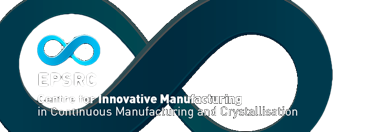Research Theme 1 -Continuous Manufacturing of Solid Particles

Modular Continuous Test Bench, Process Analysis & Manufacture of Optimised Particles
Alastair Florence, Gavin Halbert, David Littlejohn, Alison Nordon, Chris Price, Jan Sefcik ( University of Strathclyde )
WP1.1: A Modular Test Bench for Continuous Nucleation and Crystallization . Develop a test bench of plug-and-play components for integrated continuous crystallisation including laminar and turbulent conditions to study nucleation, growth, agglomeration, breakage.
WP1.2: In Situ and Non-invasive Measurement Technologies for Monitoring and Control of Processes. Develop a range of measurement techniques that can be deployed to monitor particle growth and composition, transportation of particles and subsequent processing (Raman, ATR-MIR, ATR-UV/Vis, passive/ active acoustic spectrometry, photonic measurements of refractive index).
WP1.3: Formulation of Optimised Particles: Innovative Drug Dependent Processing and Formulation. M anufacture of particles optimised for formulation. Focus on dissolution limited materials (BCS Class II) to optimise particle performance (e.g. dissolution, compaction, flow). Fundamental limitations eliminated via co-crystals, amorphous, heterogeneous granules or molecular dispersion based particles. Continuous spray drying or extrusion provide orthogonal options. Generic suite of guidelines for handling difficult compounds.
Continuous Manufacture of Robust and New Solid Materials
Xiong-wei Ni (Heriot-Watt); Colin Pulham ( University of Edinburgh ); Chris Rielly, Zoltan Nagy (Loughborough University )
WP2.1: Understanding COBC for Continuous Crystallisation. Control nucleation in continuous flow environment to achieve controlled/predictable scale up and demonstrate robustness, reliability and repeatability of continuous operation. Explore flow field using Digital Particle Image Velocimetry and CFD. Match nucleation/growth with flow conditions to control crystal quality. Characterization of COBC to provide critical and detailed knowledge on fluid mixing/dispersion, heat/mass transfer; understand how flow/operating conditions affect nucleation and growth, establish a robust set of operating and design rules.
WP2.2: Direct Nucleation and Model Predictive Control for Continuous Crystallisation. Develop combined direct nucleation control (DNC) and model predictive control (MPC) for continuous crystallisation process equipment for control of particle size distribution (PSD), habit and polymorphic form regardless of scale and flow conditions. Translate control methods to other devices, utilising PAT tools developed across the Centre. Application of DNC and MPC methodologies for issues of scale up/down, variation of production rate and PSD, and relevant software-based design tools for prediction of continuous crystalliser performance.
Crystallisation for Fabrication and Manufacture of New Molecules
Lee Cronin ( University of Glasgow ); Chick Wilson ( University of Bath )
WP3.1: Crystallisation Pull in Organic and Inorganic Systems. Examine crystallisation of continuously reacting feed-solutions and manipulate crystallisation to select different reaction/self-assembly pathways. A lab-scale continuous flow system process built based upon a novel OBR and Evolvable Process Design platform. Approaches to organic 'products' involving coupled condensation reactions and to inorganic 'products' involving reaction aggregation (quantum dots, coated gold nanoparticles) will be included.
WP3.2: Kinetics / Multi-component Systems. 1: In-situ monitoring of reaction kinetics and particle size. 2: Self assembly and control of multi-component and heterogenous particles under flow as a route to manufacturing new/controllable materials and particles (co-crystallisation, molecular level templating and additive control, defect and impurity control in self-assembling systems, and macroscopic scale multi-component systems under flow).
WP3.3: Integration / Scale Up . WP3.3 will ensure that the flow system from WP3.1 and the monitoring/feed-back systems from WP3.2 allow for scale up and integration with the other control systems and flow systems being built in nodes 1 and 2.


